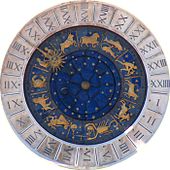Gemini (astrology)
| Gemini | |
|---|---|
 | |
| Zodiac symbol | Twins |
| Duration (tropical, western) | May 20 – June 20 (2024, UT1)[1] |
| Constellation | Gemini |
| Zodiac element | Air |
| Zodiac quality | Mutable |
| Sign ruler | Mercury |
| Detriment | Jupiter |
| Exaltation | North Node |
| Fall | South Node |
| Astrology |
|---|
 |
| Background |
| Traditions |
| Branches |
| Astrological signs |
| Symbols |
Gemini (♊︎) (/ˈdʒɛmɪnaɪ/ JEM-in-eye [2] Greek: Δίδυμοι, romanized: Dídymoi, Latin for "twins") is the third astrological sign in the zodiac. Under the tropical zodiac, the sun transits this sign between about May 21 to June 21.[3] Gemini is represented by the twins, Castor and Pollux,[4] known as the Dioscuri in Greek mythology. It is known as a positive, mutable sign.
Mythology
[edit]In Babylonian astronomy, the stars Pollux and Castor were known as the Great Twins. Their names were Lugal-irra and Meslamta-ea, meaning "The Mighty King" and "The One who has arisen from the Underworld". Both names are titles of Nergal. Also could be referencing Zeus and Hades.[5]
In Greek mythology, Gemini is associated with the myth of Castor and Pollux, a pair of twins conceived by different fathers. Zeus, who seduced Leda and conceived Pollux while Tyndareus, the king of Sparta and Leda's husband, conceived Castor. When Castor died, because he was a mortal, Pollux begged his father Zeus to give Castor immortality, which was done through uniting them together in the heavens.
In popular culture
[edit]NASA named its two-person space capsule Project Gemini after the zodiac sign because the spacecraft could carry two astronauts.[6]
Google's next-generation AI model announced on December 6, 2023, is named Gemini.[7]
Gallery
[edit]-
From the medieval Georgian manuscript of a 12th-century astrological treatise
-
Ornamentation from an altar cloth from 13th-century Germany. The two figures are depicted with the heads of dogs.
-
Gemini (al-Gawzaa) depicted in the 14th/15th-century Arabic astrology text Book of Wonders
-
Gemini by Willem Blaeu, 1602
-
White and Black Geminis by Arija, 1904
See also
[edit]Notes
[edit]- ^ Astronomical Applications Department 2011.
- ^ Unicode Consortium 2015.
- ^ Britannica n.d.
- ^ Oxford 2018, entries for Gemini and Cancer.
- ^ White 2008, p. 125.
- ^ Humans n.d.
- ^ "Introducing Gemini: our largest and most capable AI model". Google. December 6, 2023. Retrieved December 6, 2023.
References
[edit]- Astronomical Applications Department (2011). Multiyear Computer Interactive Almanac. 2.2.2. Washington DC: US Naval Observatory. Longitude of Sun, apparent geocentric ecliptic of date, interpolated to find time of crossing 0°, 30°....
- "English Oxford Living Dictionary". Oxford University Press. 2018. Archived from the original on September 20, 2016.
- "Gemini". Encyclopedia Britannica. n.d. Retrieved January 3, 2022.
- "Humans in Space". National Air and Space Museum. Smithsonian. n.d. Archived from the original on June 1, 2016. Retrieved April 20, 2022.
- Unicode Consortium (2015). "Unicode 8.0 Character Code Charts" (PDF). Retrieved April 21, 2016.
- White, Gavin (2008). Babylonian Star-lore. Solaria Pubs.






